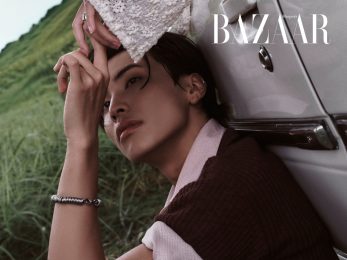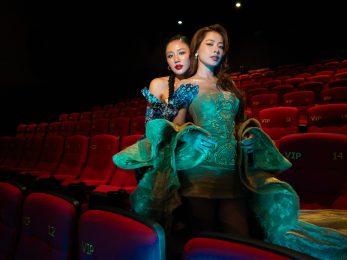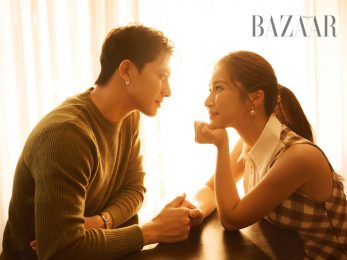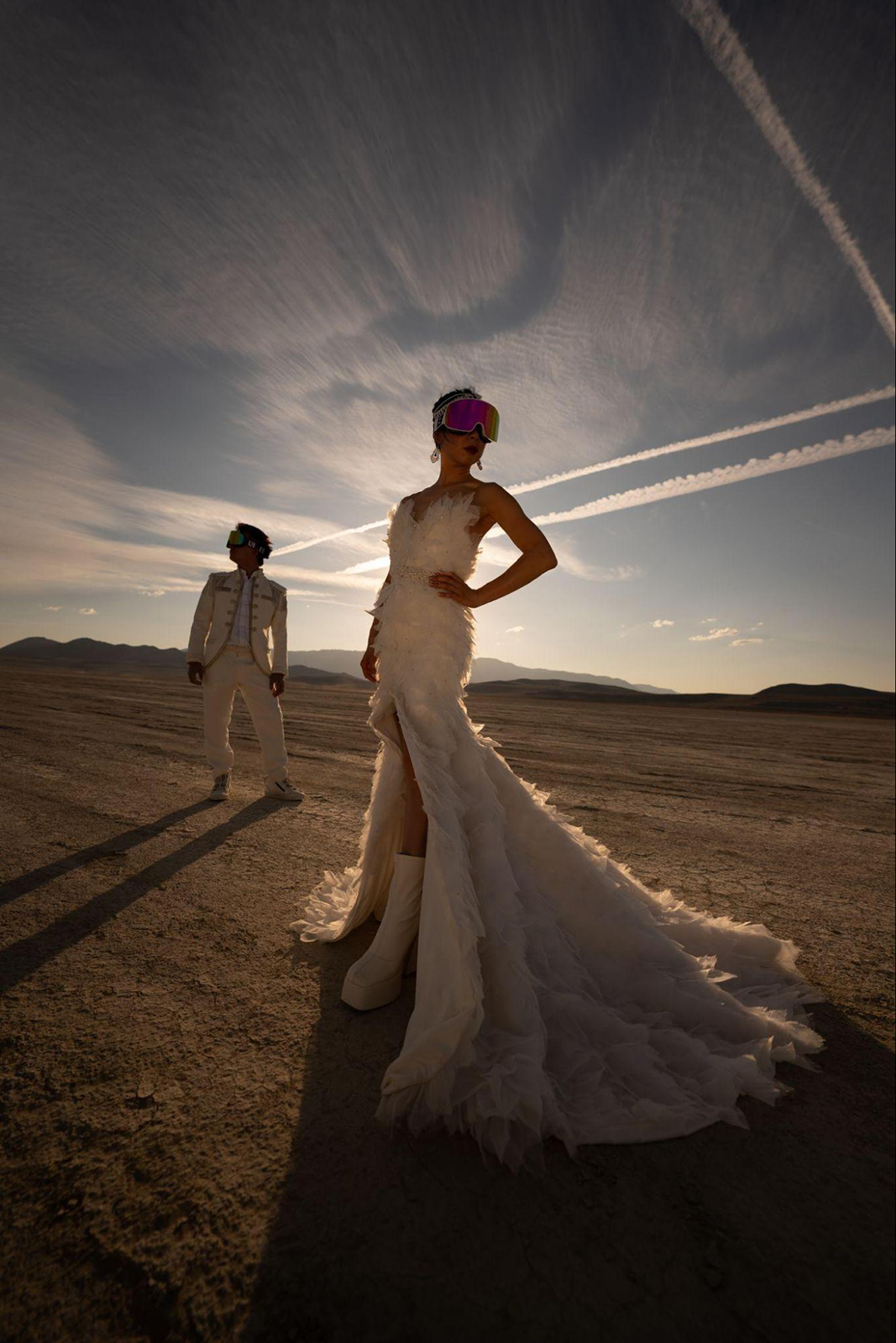
Burning Man is famous for its approach to radical inclusion — the idea that people from all walks of life are welcome within its borders and accepted with no reservations. In adopting this mindset, it’s become the perfect canvas for artists around the world to bring their unique perspectives and paint a beautifully diverse landscape of culture.
It’s these qualities that made Burning Man the perfect site for the union of Weixing Chen and Audrey Lo, a consultant, performer, and creative visionary. It was a wedding that featured a dazzling blend of Chinese tradition, Mexican craftsmanship, and avant-garde artistry. Showcasing lion dancers, couture gowns embroidered with Eastern symbolism, and a traditional Chinese tea ceremony, Audrey and Weixing’s wedding broke down cultural barriers and redefined tradition in a living dialogue between East and West.
In doing so, it proved that culture shouldn’t be confined to convention — rather, that it flourishes in remarkable ways when traditional boundaries disappear.
A love story born on the playa
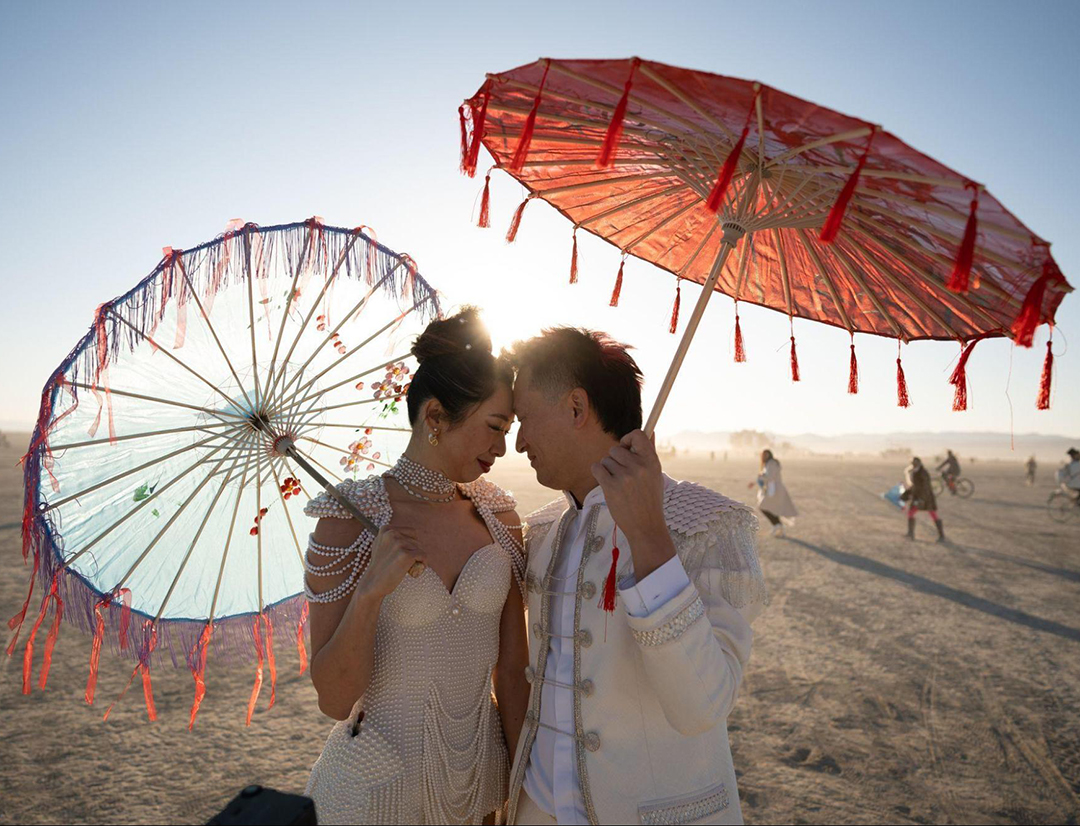
Burning Man is far more than it may seem from the outside looking in — it’s a full-fledged temporary city built by its own participants, a desert cosmopolis devoted to creativity.
But for Audrey and Weixing, Burning Man isn’t just a mecca of artistic expression; it’s the foundation of their entire relationship. Audrey first attended Burning Man twelve years ago in a self-described transformative experience and has since played a role in creating some of the event’s most iconic experiences. But it took on a deeper meaning for her when she met her future husband on the Playa a few years ago. He proposed to her the following year, forever cementing Burning Man as one of the most important places in their lives.
It should come as no surprise, then, that the duo was determined to get married at the festival as well. It’s something Audrey had been dreaming of for years: “From the first year I went, 12 years ago,” she shares. “I think I’ve always known that this was the place I wanted to get married.”
But their decision to marry at Burning Man was grounded in more than just sentiment — it was also about celebrating an under-represented demographic. Less than 10% of attendees are Asian, and despite the festival being a radically inclusive space that welcomes every tradition and background, there’s still an unspoken perception that Burning Man is a Western celebration.
Audrey’s response to this perception was a wholehearted celebration of her Chinese heritage in an East-meets-West merging of tradition and creativity. Central to this celebration were two thoughtfully executed expressions of heritage and art: the Long Feng Art Car and a stunning fashion collection — both of which became powerful symbols of cultural storytelling and artistic collaboration.
The result was a wedding that served as an impactful reminder that Burning Man’s values of creativity and inclusion transcend geographic and cultural boundaries, giving room for diverse expressions of love and identity.
The Long Feng Art Car: A Monument to Cultural Fusion
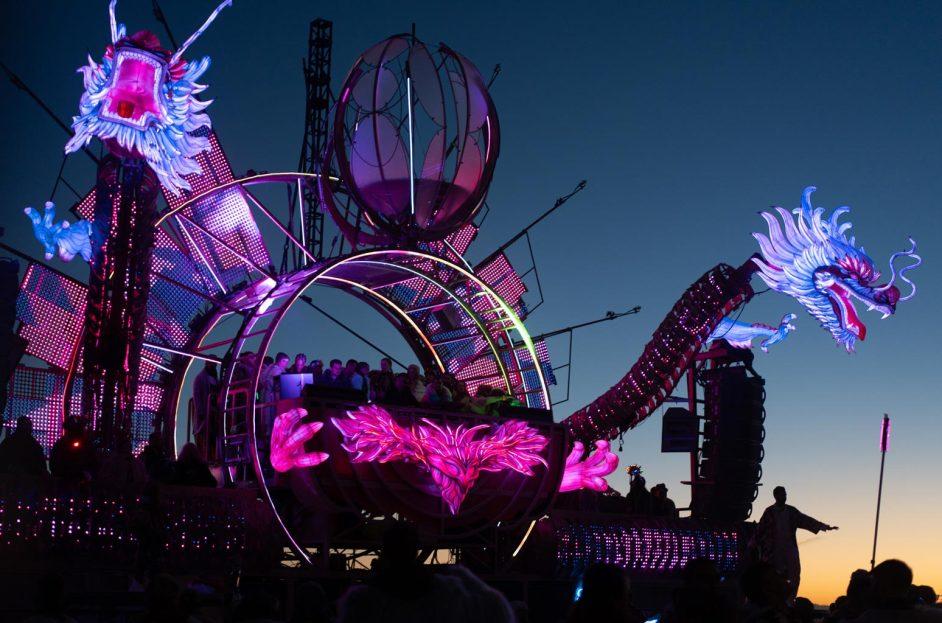
Source: Billboard.
Art cars, or “mutant vehicles,” have long been a staple of the Burning Man experience. Combining engineering ingenuity with unique expressions of creativity, they’re a defining feature of the festival and the perfect opportunity for Audrey and Weixing to express their love in an unforgettable fashion.
Enter the Long Feng Art Car, a magnificent mobile installation that symbolized the marriage of Eastern and Western philosophies. Conceptualized and designed by Audrey, the car represented the harmonious union of the dragon (embodying Eastern philosophy and tradition) and the phoenix (symbolizing Western beauty and faith). At the pinnacle of the installation rested a white pearl — a traditional Chinese emblem of new life and potential — representing the merging of these two paradigms and the birth of a global culture and community through love, fun, and music.
The art car was also a technological and artistic marvel that was built in collaboration between Mexican and Chinese artisans and engineers, reinforcing the recurring theme of East-meets-West fusion. Constructed in less than a year, it incorporated massive animatronic dragon heads and avant-garde structural features, including elaborate rigging systems for aerial artists. Its dance floors could accommodate up to 40 performers, creating a moving, breathing theater on wheels. To top it all off, the installation was equipped with pyrotechnics, lasers, and LED screens, transforming the desert night into a spectacular canvas of sound, light, and movement.
To Audrey, the car was a manifestation of multiple lifelong passions. She’s always been a performer, a community builder, and a lover of Burning Man, and she’s always dreamed of building her own art car. But the Long Feng Art Car was also the child of a global union, one that bridged cultures, celebrated diversity, and demonstrated how radical creativity and collaboration can create moments that transcend both art and tradition.
Couture as cultural storytelling
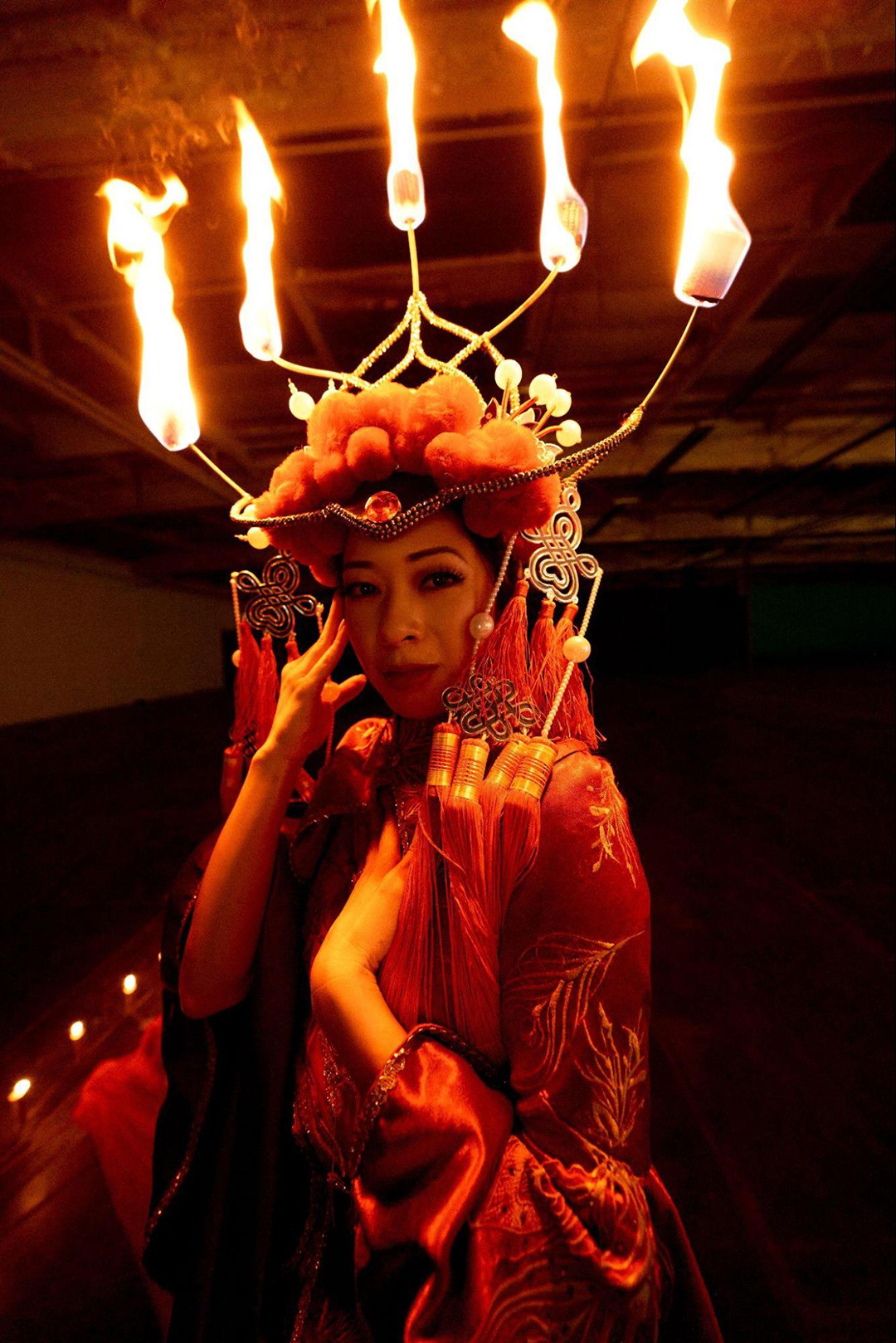
While the art car served as the structural centerpiece for the wedding, the element that tied everything together was the fashion. Throughout the celebration, Audrey debuted a carefully curated set of outfits that paid homage to her Chinese heritage — yet one that was primarily designed by Mexican couturier Emmanuel Victoria in another culmination of global cultural fusion.
The highlight of the collection was the unforgettable Phoenix Dress, a fire-lit wedding gown meticulously crafted by Mexican artisans in a feat of technical artistry wrought with cultural symbolism. Featuring an elegant qipao-inspired silhouette and trimmed with handcrafted gold-thread embroidery, the dress was a fiery union of Eastern aesthetics and the theatrical drama of Western couture.
A detachable, candle-laden train glided across the desert floor above hidden wheels, mimicking trailing flames while allowing for graceful, effortless movement. Stitched from fire-resistant materials and borne by carefully tested structural supports, the Phoenix Dress allowed Audrey to safely embody the transformative spirit of the phoenix without sacrificing the dress’s visual grandeur.
“This particular dress was really special to me,” Audrey says. “I always knew I wanted something symbolic of the Phoenix rising, coming from an eastern background.”
Also contributing to the multicultural narrative of Audrey’s wedding was close friend and designer Rachelle Appelle. Featured in a photo shoot on the Playa, Audrey first appeared in a striking white faux-feather gown adorned with pearls and rhinestones, symbolizing purity and renewal. Following this look, she underwent the mythical rebirth of the phoenix, her outfit transforming into a modern red and gold cheongsam. Complementing Audrey, Weixing transitioned from an ivory silk, military-style suit to a dynamic red, gold, and black silk ensemble intricately detailed with dragon scales, symbolizing power, strength, and auspicious fortune.
Both Emmanuel and Rachelle’s creations were the product of meticulous craftsmanship and profound cultural storytelling, from Emmanuel’s Mexican artisanal techniques to Rachelle taking inspiration from the traditional Chinese opera. The result was a couture collection that bridged Mexican artistry, Chinese fashion, and avant-garde aesthetics, emphasizing Audrey and Weixing’s roots and artistic personas while representing their heritage in an unapologetically beautiful way.
A wedding that brought cultures together
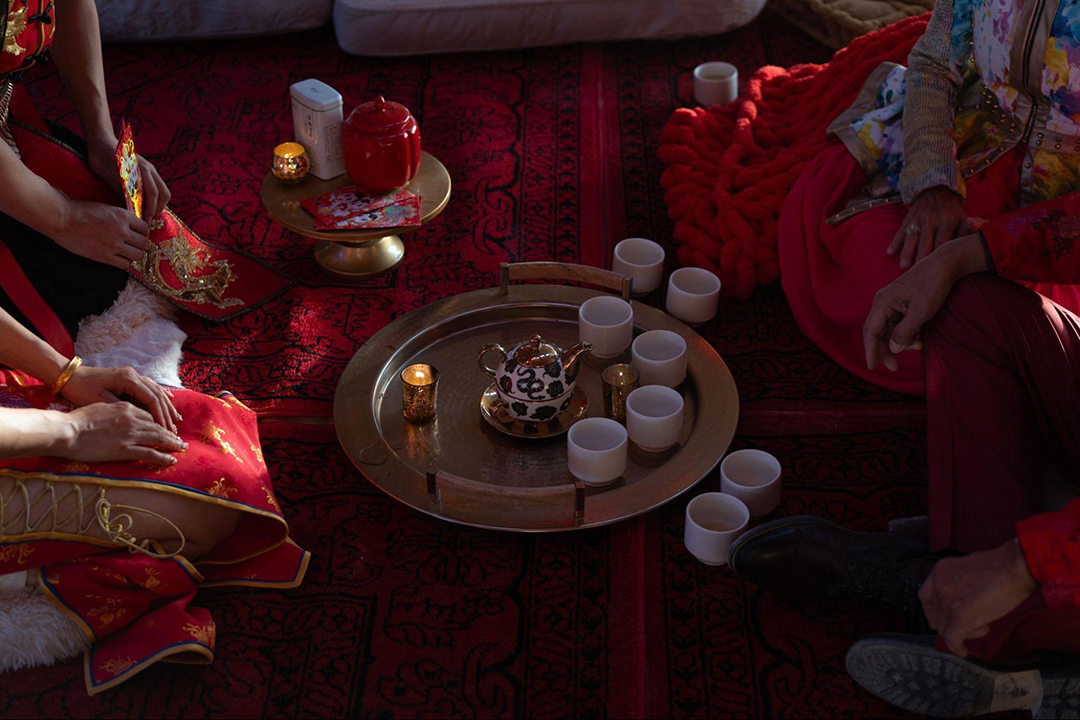
From the Long Feng Art Car to the strikingly Eastern influence on the fashion of the celebration, Audrey and Weixing’s wedding reimagined traditional customs through the lens of Burning Man’s inclusive ethos. Rather than simply transplanting a conventional Chinese wedding onto the grounds of the Playa, they created something entirely new that couldn’t have been achieved anywhere else in the world — an immersive experience that embraced their heritage and the creative freedom inherent to Burning Man.
Vibrant performances that would have felt right at home on the streets of Shanghai animated the desert landscape. Lion dancers, symbols of prosperity and good luck, twirled through the dirt, bridging the ancient East with the contemporary West. Animatronic dragons cocked their heads and gazed at the awestruck attendees. Silk dancers adorned the art car as they swayed in midair.
The festivities continued as Audrey and Weixing hosted their wedding banquet, which was thoughtfully inspired by traditional Hong Kong wedding feasts but adapted for the Playa’s communal atmosphere — transforming a classic cultural practice into a modern, collective dining experience unique to Burning Man.
But one of the most significant moments of the wedding was a Chinese tea ceremony, a deeply emotional event that symbolizes respect, unity, and familial blessing. Audrey and Weixing reimagined this sacred ceremony in the heart of the desert, honoring their parents with a significant cultural ritual that was seamlessly integrated into their new world.
For Audrey and Weixing’s families, the wedding was a dazzling experience that challenged traditions in a striking way. Coming from traditional Chinese backgrounds, the radically inclusive, artistic, and participatory environment of Burning Man was a fascinating change of pace. “My whole family went,” Audrey says. “My 70-something-year-old parents walked me down the aisle, and it was their first time. They were mind-blown. Weixing’s family also came, and they’d never heard of anything like this. Being from China, in such a conservative culture, it was so eye-opening for them.”
Bridging worlds through creative expression
By seamlessly merging Chinese tradition with Mexican craftsmanship and the kind of artistic freedom found only at Burning Man, Audrey and Weixing’s wedding demonstrated the meaningful impact of genuine cultural collaboration.
It wasn’t just a ceremony; it was East-meets-West performance and artwork made manifest on the desert landscape of the Playa. It was an authentic, immersive experience where guests actively engaged in the festivities rather than merely observing them. Redefining heritage and cultural storytelling, their wedding is a powerful illustration of how traditions can become even more meaningful when approached with creativity and collaboration.
Harper’s Bazaar Vietnam
Photographer: Benji Kaiyo


